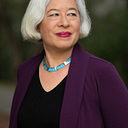We Have the Power to Unify Our Country
Dialogue can help us bridge the political divide

Calls for unity have been met with considerable skepticism. Is it possible, or even desirable, to seek unity at the current zenith of political polarization? Indeed, polls indicate that Republicans and Democrats are deeply divided about guns, race, climate, immigration, and COVID-19. To be sure, a divided America is a troubling phenomenon, but it’s not the whole story; and our limited view undermines confidence that unity can be achieved. Moreover, misperception of polarization is damaging our health, our relationships, and our democracy. The good news is that we can do something about it.
What are we getting wrong in our thinking about the political landscape? First, we overestimate the extent to which people are at the extremes. Decades of research consistently shows that Republicans and Democrats perceive each other as holding more extreme views than they actually do. This perception gap is widening, as partisans overestimate the ideological extremism and demographic composition of people in the other party. Critics of unity echo these misperceptions as they express abhorrence at the idea of unifying with extremists.
While there are, indeed, people who hold extreme political views, research reveals that two thirds of Americans are closer to the middle, the “Exhausted Majority.” Whereas people farther on the Left and the Right share strong feelings about issues and deep engagement in politics, others are characterized by their aversion to political junkies and detachment from the political process. In other words, people can be differentiated, not based on the orientation of their political views, but rather the force of them.
It’s clear from these studies that most people are not reflected in the narrative of polarization between the left and right. Yet, polarization is what we hear about. People who are more deeply committed to politics and to extremes of either side tend to speak out, engage in social media, and participate in visible movements. Furthermore, political polarization is compelling to journalists — more extreme views make a better story than interviewees who lack interest in politics. Not surprisingly, the more people consume polarizing media, the less accurate their perceptions are of the opposing party.
So, how do inaccurate perceptions of political polarization and of people on “the other side” affect us? First, perceived polarization is compromising our health, with two-thirds of Americans citing the current political climate as a significant source of stress. Second, because we misjudge people as more extreme than they are and view them as uninformed and uncaring, we may avoid and unfriend people due to distorted understandings of who they are. Finally, we’re damaging our democracy. The Exhausted Majority, those for whom politics is not their priority, are not only avoiding people on the Left and Right, they are disengaging from political participation, including voting.
How can we accurately appraise political disagreement to guide efforts toward unity? Of course, we can identify politicians, news outlets, and social media platforms that amplify the narrative of polarization. Rather than railing against these culprits, however, we can take matters into our own hands and focus on solutions that we have the power to implement. I have spent the past four years delving into research and engaging people in conversations about bridging the political divide and over two decades teaching skills that help people connect. Both evidence and experience point to a powerful tool that every one of us can implement: dialogue.
Dialogue is not debate (which is about winning) or diatribe (which is about venting), but rather conversation that promotes connection and understanding. It builds on a foundation of respect for and curiosity about views that are different from one’s own. Applying tools for listening, exploration of values and experiences, and managing emotions can help both parties to stay engaged as they hear perspectives that push their buttons. Crucially, these exchanges need to take place face-to-face, not Facebook-to-Facebook.
Dialogue is not debate (which is about winning) or diatribe (which is about venting), but rather conversation that promotes connection and understanding.
How will dialogue help? Imagine family members who hold strong opposing views engaging in conversation with a shared goal of understanding each other. Rather than expressing forceful arguments, they ask one another how they came to their views and share their own journeys. They might react to an unsettling opinion with curiosity, not frustration. They would be unlikely to change each other’s mind about policies, but they may develop more accurate and more complex views of a person who holds an opposing position. Moreover, they may mend or sustain a relationship with someone who is important in their life, which is an important facet of unity.
Dialogue is informative. It can help us develop a more accurate view of others by hearing their values and experiences. Dialogue is healing. It can help us to feel close to other people by understanding them and feeling understood. Dialogue is engaging. It can welcome people into meaningful exchange about important matters. In short, dialogue is an empowering practice that can help to correct our distorted perceptions, repair our ruptured relationships, and provide a pragmatic path toward unifying our country.
Tania Israel is a Professor of Counseling Psychology at the University of California, Santa Barbara and author of Beyond Your Bubble: How to Connect Across the Political Divide, Skills and Strategies for Conversations That Work (APA, 2020).
Photo credit: Tomas Sobek on Unsplash
